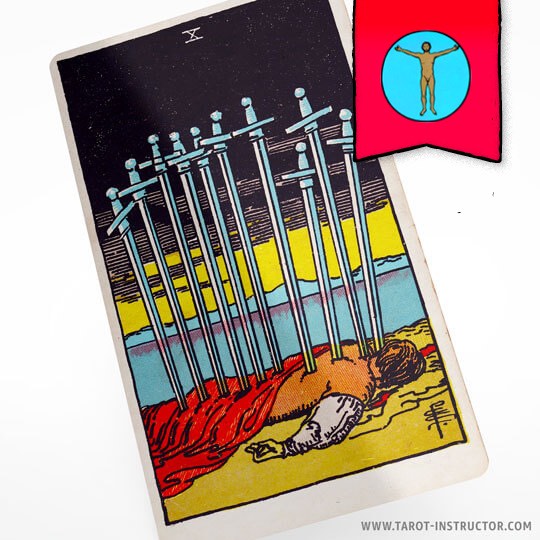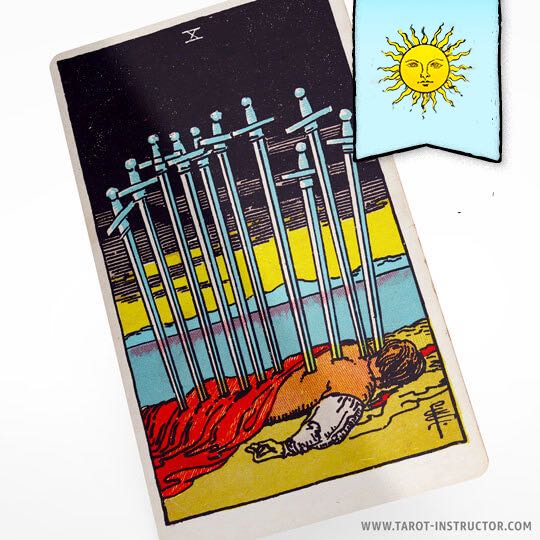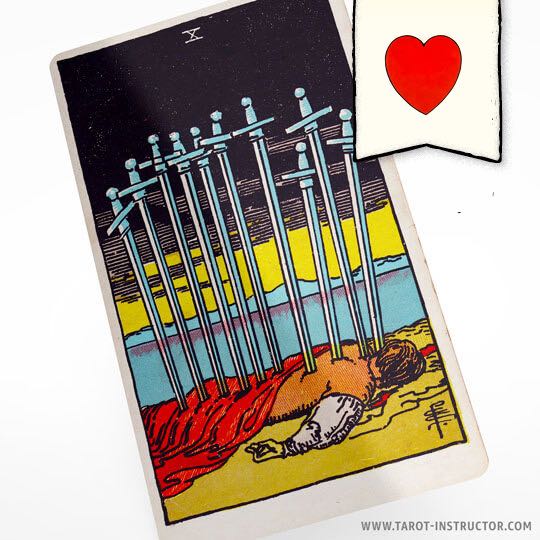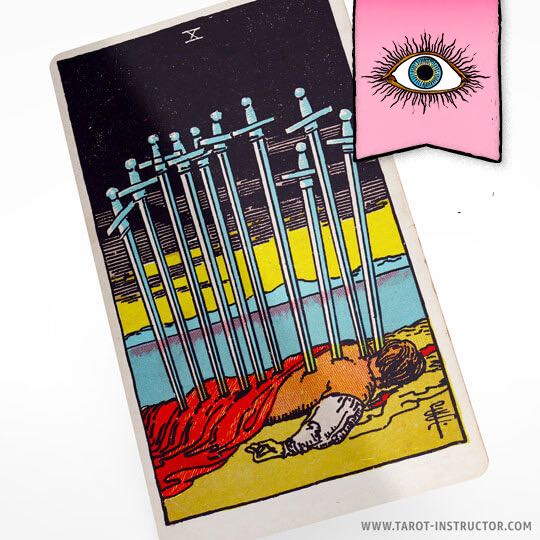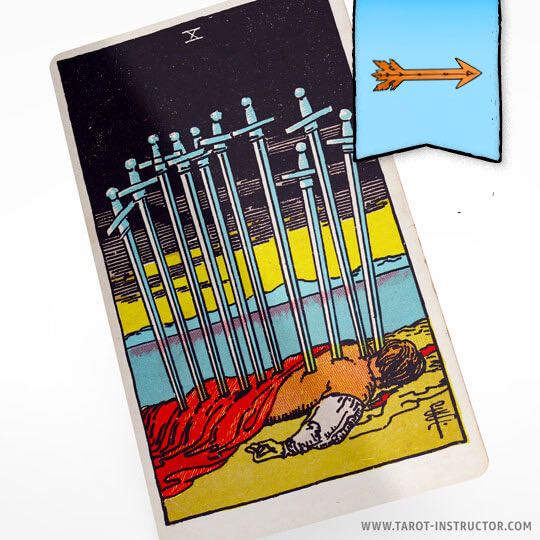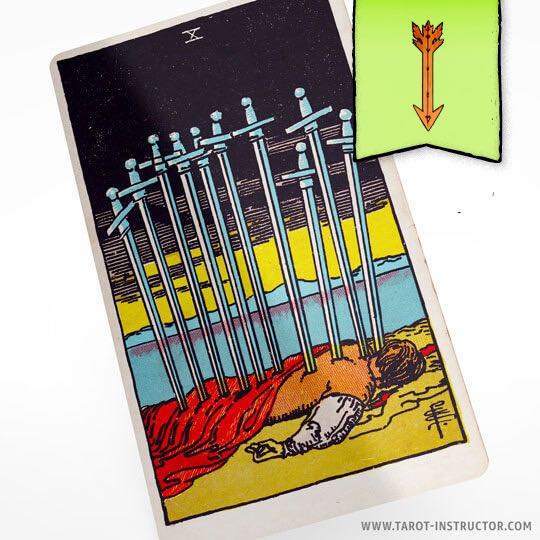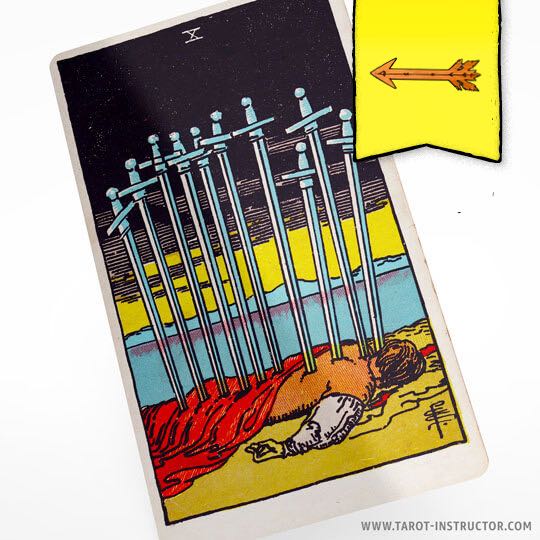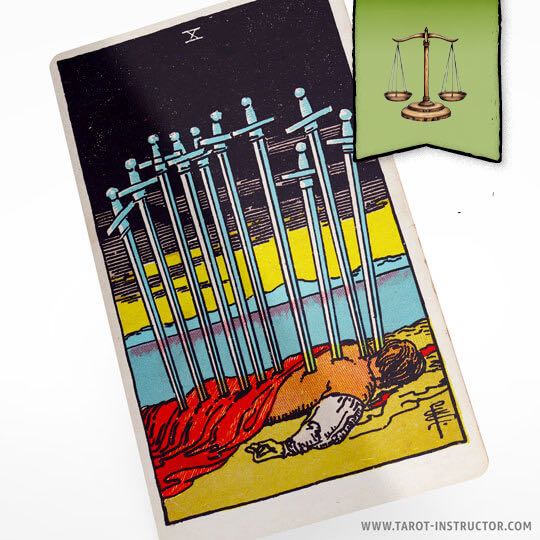Ten of Swords tarot card features following symbolic elements
Ten of Swords tarot card features following symbolic elements
Ten Swords: Feelings of betrayal lead to a painful ending, emphasizing the importance of seeking closure to heal and move on. The Figure: Helplessness in love calls for acceptance of the relationship’s end, fostering emotional healing and growth. The Sunrise: A new beginning emerges post-heartbreak, instilling hope for future love and the possibility of renewed joy. The Dark Sky: Current emotional turmoil highlights the necessity of confronting and processing pain, ultimately leading to personal growth. The Ground: The barren ground symbolizes the need for self-rebuilding, nurturing resilience, and preparing for healthier future relationships.
Table of content
Ten of Swords as advice
„Accept endings as a necessary step towards new beginnings.“
Ten of Swords keywords upright
Endings, Betrayal, Loss, Finality, Conclusion, Transformation.
Ten of Swords keywords reversed
Recovery, Rebirth, Renewal, Resilience, Survival, New Beginnings.
Ten of Swords card element
Air
Ten of Swords zodiac sign
Gemini
Ten of Swords as a Person: Understanding Its Depths
When exploring tarot, each card reveals a story about personality, character, and behavior. Among the 78 tarot cards, the Ten of Swords as a person symbolizes pain, betrayal, and the end of a difficult chapter. This article delves into the Ten of Swords as a person, examining what it means when upright and reversed, and how it manifests in men and women alike. If you’re curious about the Ten of Swords as a person, read on to discover its intricate meanings and insights.
The Ten of Swords as a Person: An Overview
The Ten of Swords as a person embodies a figure who has faced hardship and hardship has left its mark. This card signifies someone who has experienced profound disappointment, loss, or betrayal. When considering the Ten of Swords as a person, think of someone who carries scars—both visible and invisible—that tell a story of resilience and pain.
The Ten of Swords as a Person Upright
When interpreting the Ten of Swords as a person in the upright position, we see an individual who has gone through a tumultuous period. This person may appear exhausted, wounded, or overwhelmed by life’s hardships. They often carry a sense of finality, as if they have reached a breaking point but are also on the cusp of new beginnings.
The upright Ten of Swords as a person is someone who has endured betrayal or failure but is now ready to let go of the past. They understand that the pain they have faced is part of their growth and are prepared to move forward, even if it feels painful.
This person may be at a crossroads, having just experienced a loss or ending that feels devastating. They might seem defeated, but beneath that surface lies a resilience that pushes them toward healing. Their journey involves accepting the pain, learning from it, and ultimately rising above it.
However, it’s important for this person to avoid dwelling on despair. While acknowledging pain is vital, they must also recognize the potential for renewal and hope. The upright Ten of Swords as a person encourages embracing closure and preparing for a fresh start.
The Ten of Swords as a Person Reversed
In reverse, the Ten of Swords as a person takes on a different meaning. This individual might be resistant to facing their pain or refusing to accept endings. They could be in denial about a loss or trauma, avoiding the emotional truth that needs to be confronted.
The reversed Ten of Swords as a person can also signify someone who is stuck in the cycle of regret or self-pity. They may be obsessing over past mistakes, unable to release the hurt or forgive themselves and others. This resistance to change can hinder their ability to heal and move forward.
Additionally, this person might be experiencing a sense of stagnation, feeling as if they are in a dark tunnel with no light at the end. They may be overwhelmed by feelings of betrayal, guilt, or despair but lack the energy or clarity to make necessary changes.
In this state, the reversed Ten of Swords as a person needs to practice self-compassion and patience. Releasing the grip of pain and accepting that endings are a natural part of life can help them heal. They should focus on small steps toward recovery, trusting that brighter days are ahead.
The Ten of Swords as a Man
When considering the Ten of Swords as a person in terms of gender, the archetype of the man embodies someone who has faced adversity and carries the weight of past wounds.
The Ten of Swords as a Man Upright
In the upright position, the Ten of Swords as a man is often seen as a figure who has endured significant hardship. He may appear wounded, exhausted, or emotionally drained. Despite this, he possesses a quiet strength rooted in having survived difficult times.
This man might be someone who has experienced betrayal or failure but is now on the path of healing. His resilience is evident, even if he feels defeated temporarily. He is in a phase of reflection, acknowledging his pain but also preparing for renewal.
He might have recently gone through a breakup, a career setback, or personal loss. His journey involves accepting the end of a chapter and understanding that pain is part of growth. His experience teaches others that resilience can emerge from even the darkest moments.
However, the Ten of Swords as a man in this position should be cautious not to become trapped in victimhood or hopelessness. Recognizing the lessons from hardship can empower him to rebuild and move forward.
The Ten of Swords as a Man Reversed
In reverse, the Ten of Swords as a man may struggle with denial or resistance to healing. He could be refusing to accept the end of a difficult phase, clinging to the past out of fear or insecurity.
This man might be acting out of stubbornness or refusing to see the truth of his situation. He may be sabotaging his progress by avoiding emotional work or refusing to forgive himself or others.
He might also feel overwhelmed by guilt or regret, feeling as if he has failed beyond repair. This self-imposed stagnation can prevent him from experiencing growth and renewal.
In this state, the Ten of Swords as a man in reverse calls for introspection and self-awareness. Releasing blame and embracing acceptance can help him find peace and clarity. Healing begins when he allows himself to confront his pain honestly.
The Ten of Swords as a Woman
Turning to the Ten of Swords as a woman, this archetype signifies someone who has endured hardship but is also capable of resilience and rebirth.
The Ten of Swords as a Woman Upright
When upright, the Ten of Swords as a woman embodies strength born from adversity. She may have faced betrayal, heartbreak, or disappointment, but she refuses to let these define her. Her journey involves acknowledging her pain while moving toward recovery.
This woman is often seen as courageous, willing to confront her wounds head-on. Her resilience inspires others, and she understands that endings are essential for new beginnings.
She may be recovering from a breakup, loss of a loved one, or personal failure. Her experience teaches that pain, while intense, can be a catalyst for transformation. Her attitude is one of acceptance and hope, even in the darkest moments.
However, she must be mindful not to dwell excessively on pain. Finding balance between honoring her feelings and embracing positivity is key to her healing process.
The Ten of Swords as a Woman Reversed
In reverse, the Ten of Swords as a woman may indicate she is avoiding or suppressing her pain. She might be in denial about her suffering or unwilling to confront the truth of her situation.
This resistance can manifest as self-isolation, emotional numbness, or repeated patterns of self-sabotage. She may feel overwhelmed by feelings of betrayal or failure but lacks the tools to process them healthily.
This phase requires her to practice self-compassion and allow herself to grieve. Releasing the need for control and accepting her vulnerability can open the door to healing.
The reversed Ten of Swords as a woman reminds her that healing is a journey, and sometimes surrendering control is necessary for growth.
Conclusion
The Ten of Swords as a person, whether upright or reversed, offers profound insights into pain, resilience, and transformation. This card embodies the reality that endings and suffering are part of life’s cycle, but they also pave the way for new beginnings.
When exploring the Ten of Swords as a person, whether as a man or woman, we see that both archetypes face challenges but also possess the inner strength to heal and grow. The upright symbolizes acceptance, resilience, and hope, while the reversed highlights the importance of confronting pain and embracing change.
Ultimately, the Ten of Swords as a person teaches us that even after the darkest nights, dawn will come. Embracing pain with compassion, accepting endings, and trusting in the process of renewal are vital steps toward healing.
Remember, the Ten of Swords as a person reminds us that sometimes, the greatest growth begins after the fall. Embrace your journey, learn from the pain, and step confidently into the light of a new beginning.
Source: Wikipedia Ten of Swords tarot card meaning
Reddit Ten of Swords
Quora Ten of Swords meaning
Tarot Forum 10 of Swords as a Person
Unlock the mysteries of tarot cards.
